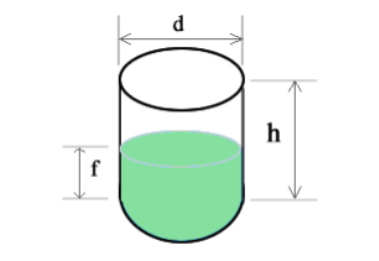Vertical Cylinder Tank Volume Calculator - Calculate volume in litres, gallons, cubic feet, bbl, cubic meters

Vertical Cylinder Tank Volume Description
A vertical cylinder tank is a container with a cylindrical shape, where the height of the cylinder is perpendicular to its circular base. The tank's dimensions include its radius \( r \) and height \( h \). The total volume of a vertical cylindrical tank can be determined by multiplying the area of the circular end by the height of the tank.
Formula for Total VolumeThe area \( A \) of the circular end is calculated using the formula:
\[ A = \pi r^2 \]
Where:
- r = radius of the circular base (half of the diameter \( d \) of the tank)
To calculate the total volume of the vertical cylinder tank, we multiply the area of the base by the height \( h \) of the tank:
\[ V_{\text{tank}} = \pi r^2 h \]
Where:
- r = radius of the tank's circular base
- h = height of the tank
If the tank is partially filled, the filled volume forms a smaller cylinder with the same radius \( r \) as the full tank, but with a height equal to the fill height \( f \). The formula for the filled volume of the tank is:
\[ V_{\text{fill}} = \pi r^2 f \]
Where:
- r = radius of the tank's circular base
- f = fill height of the tank
For a vertical cylinder tank with a radius of 5 meters and a height of 10 meters, the total volume would be:
\[ V_{\text{tank}} = \pi (5)^2 \times 10 \approx 785.4 \, \text{cubic meters} \]
Thus, the total volume of the tank is approximately 785.4 cubic meters.
Example 2: Calculating Filled VolumeIf the tank from Example 1 is filled to a height of 4 meters, the filled volume would be:
\[ V_{\text{fill}} = \pi (5)^2 \times 4 \approx 314.16 \, \text{cubic meters} \]
Therefore, the filled volume is approximately 314.16 cubic meters.
-
Q: What happens if the tank is filled above its height?
A: If the fill height exceeds the height of the tank, the tank would overflow. The calculated volume is valid only for the portion within the height of the tank. -
Q: Can the formula be used for a tank with an irregular shape?
A: No, the formula \( V = \pi r^2 h \) applies only to a tank with a cylindrical shape. For irregular shapes, different volume calculation methods are needed. -
Q: Can I calculate the volume of a tank if only the diameter is given instead of the radius?
A: Yes, if the diameter \( d \) of the tank is provided, the radius can be calculated by dividing the diameter by 2. The formula for volume remains the same, but with \( r = \frac{d}{2} \).
 Home
Home Back
Back